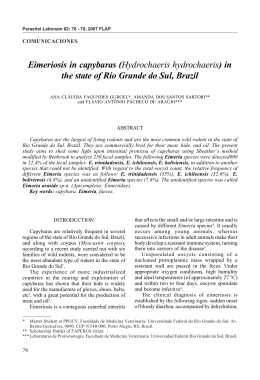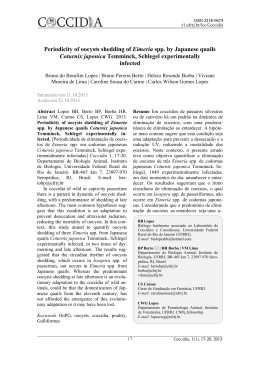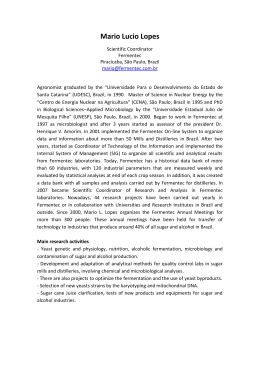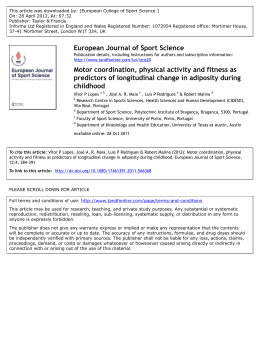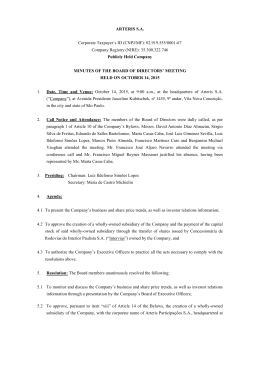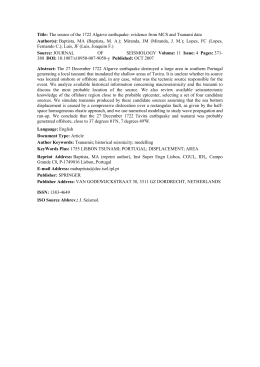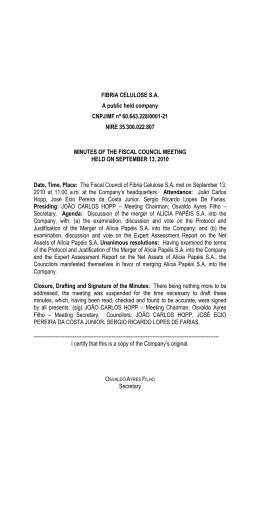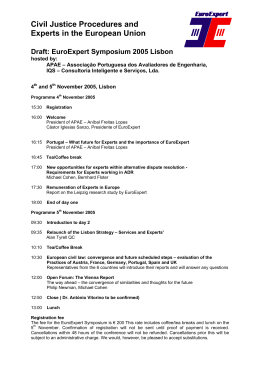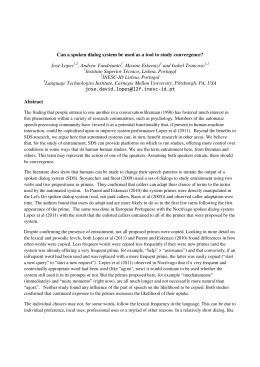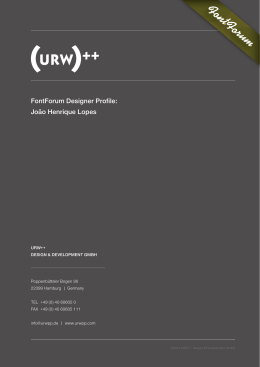Coccidia of New World psittaciform birds (Aves: Psittaciformes): Eimeria ararae n. sp. (Apicomplexa: Eimeriidae) from the blue-and-yellow macaw Ara ararauna (Linnaeus) Bruno do Bomfim Lopes, Bruno Pereira Berto, Lianna Maria de Carvalho Balthazar, Cleide Domingues Coelho, Daniel Medeiros Neves, et al. Systematic Parasitology An International Journal ISSN 0165-5752 Volume 88 Number 2 Syst Parasitol (2014) 88:175-180 DOI 10.1007/s11230-014-9490-7 1 23 Your article is protected by copyright and all rights are held exclusively by Springer Science +Business Media Dordrecht. This e-offprint is for personal use only and shall not be selfarchived in electronic repositories. If you wish to self-archive your article, please use the accepted manuscript version for posting on your own website. You may further deposit the accepted manuscript version in any repository, provided it is only made publicly available 12 months after official publication or later and provided acknowledgement is given to the original source of publication and a link is inserted to the published article on Springer's website. The link must be accompanied by the following text: "The final publication is available at link.springer.com”. 1 23 Author's personal copy Syst Parasitol (2014) 88:175–180 DOI 10.1007/s11230-014-9490-7 Coccidia of New World psittaciform birds (Aves: Psittaciformes): Eimeria ararae n. sp. (Apicomplexa: Eimeriidae) from the blue-and-yellow macaw Ara ararauna (Linnaeus) Bruno do Bomfim Lopes • Bruno Pereira Berto • Lianna Maria de Carvalho Balthazar • Cleide Domingues Coelho Daniel Medeiros Neves • Carlos Wilson Gomes Lopes • Received: 26 February 2014 / Accepted: 11 April 2014 Ó Springer Science+Business Media Dordrecht 2014 Abstract In the New World, the avian order Psittaciformes comprises 142 species, yet to date only 3 (2%) of the species have been examined for coccidia, and from these only four species of Eimeria Schneider, 1875 have been described. In this study, a new coccidian species (Protozoa: Apicomplexa: Eimeriidae) obtained from the blue-and-yellow macaw Ara ararauna (Linnaeus) is reported from Brazil. Oöcysts of Eimeria ararae n. sp. are ovoidal, measure 28.7 9 20.2 lm and have a smooth, bi-layered wall c.1.1 lm thick. Both micropyle and oöcyst residuum are absent, but polar granules are present. Sporocysts are ovoidal and measure 17.0 9 8.3 lm, with knoblike, prominent Stieda body and sporocyst residuum is composed of granules; sub-Stieda body is absent. Sporozoites are vermiform with one refractile body and a nucleus. This is the fifth description of an eimerid coccidian infecting a New World psittaciform bird. B. do Bomfim Lopes Programa de Pós-graduação em Ciência, Tecnologia e Inovação em Agropecuária, Universidade Federal Rural do Rio de Janeiro (UFRRJ), BR-465 km 7, Seropédica, RJ 23897-970, Brazil D. M. Neves Horto Florestal Mário Xavier, Centro de Triagem de Animais Silvestres (CETAS), Instituto Brasileiro do Meio Ambiente e dos Recursos Naturais Renováveis (IBAMA), Ministério do Meio Ambiente (MMA), BR-465 Km 4, Seropédica, RJ 23835-400, Brazil B. P. Berto (&) Departamento de Biologia Animal, Instituto de Biologia, UFRRJ, BR-465 km 7, Seropédica, RJ 23897-970, Brazil e-mail: [email protected] Introduction The order Psittaciformes includes 375 species worldwide. Most psittaciform birds are distributed throughout the tropical zones, but some species are found in cold areas of Patagonia, Argentina and Chile. The largest number of species occur in the New World and Oceania with 142 and 123 species, respectively. In C. W. G. Lopes Departamento de Parasitologia Animal, Instituto de Veterinária, UFRRJ, BR-465 km 7, Seropédica, RJ 23897-970, Brazil L. M. de Carvalho Balthazar Curso de Pós-Graduação em Ciências Veterinárias, UFRRJ, BR-465 km 7, Seropédica, RJ 23897-970, Brazil C. D. Coelho CTI Veterinário, Avenida das Américas, Barra da Tijuca, RJ 3939, Brazil 123 Author's personal copy 176 South America, the richest zone is the Amazon forest (IUCN, 2014). In common with other vertebrates, psittaciform birds can be infected by eimerid coccidia. Chakravarty & Kar (1946) described Isospora psittaculae Chakravarty & Kar, 1946 from Alexandrine parakeets Psittacula eupatria (Linnaeus). After this description, more species have been described or reported in the Old World and Oceania: Eimeria dunsingi Farr, 1960, Eimeria psittacina Gottschalk, 1972 and Isospora melopsittaci Bhatia, Chauhan, Arora & Agrawal, 1973 were described from budgerigars Melopsittacus undulatus (Shaw); and Eimeria haematodi Varghese, 1977 from rainbow lorikeets Trichoglossus haematodus (Linnaeus) (Farr, 1960; Gottschalk, 1972; Bhatia et al., 1973; Varghese, 1977). After these original descriptions, only E. dunsingi was reported from yellow-billed lorikeets Neopsittacus musschenbroekii (Schlegel) and musk lorikeets Glossopsitta concinna (Shaw) (Hooimeijer et al., 1993; Gartrell et al., 2000). In the New World, the first coccidian species described from psittaciform birds was Eimeria aratinga Upton & Wright, 1994 from orange-fronted parakeets Aratinga canicularis (Linnaeus) from Costa Rica (Upton & Wright, 1994). In 2011, three Eimeria spp. were described from South American parrots in Brazil: Eimeria amazonae Hofstatter & Kawazoe, 2011 and Eimeria ochrocephalae Hofstatter & Kawazoe, 2011 from the yellow-crowned Amazon Amazona ochrocephala (Gmelin); and Eimeria aestivae Hofstatter & Guaraldo, 2011 from the turquoisefronted Amazon Amazona aestiva (Linnaeus) (Hofstatter & Kawazoe, 2011; Hofstatter & Guaraldo, 2011). Recently, Balthazar et al. (2013) reported a case of coccidiosis by E. amazonae in a turquoisefronted Amazon A. aestiva kept under quarantine. The current study describes a new coccidian species infecting blue-and-yellow macaws Ara ararauna (Linnaeus) from Brazil. The birds were held in CETAS (Centro de Triagem de Animais Silvestres Centre for Screening of Wild Animals) coordinated by IBAMA/MMA (Instituto Brasileiro do Meio Ambiente e dos Recursos Naturais Renováveis - Brazilian Institute of Environment and Renewable Natural Resources/Ministério do Meio Ambiente - Brazilian Ministry of the Environment), for rehabilitation and reintroduction into the wild. 123 Syst Parasitol (2014) 88:175–180 Materials and methods Faecal samples were collected from fifteen blue-andyellow macaws recovered from the trafficking of wild animals and kept in quarantine in CETAS/IBAMA/ MMA facilities, located at the Municipality of Seropédica in the State of Rio de Janeiro, Brazil. The risk of contamination from the birds previously held was minimised because the samples were collected from newly-arrived birds in CETAS. Faeces were collected and placed in plastic vials containing 2.5% potassium dichromate solution (K2Cr2O7) 1:6 (v/v). Samples were transported to the Laboratório de Coccı́dios e Coccidioses located at the Universidade Federal Rural do Rio de Janeiro (UFRRJ). Samples were placed in a thin layer (c.5 mm) of K2Cr2O7 2.5% solution in Petri dishes, incubated at 23–28°C and monitored daily, until 70% of the oöcysts were sporulated. Oöcysts were recovered by flotation in Sheather’s sugar solution (S.G. 1.20) and microscopically examined using the technique described by Duszynski & Wilber (1997). Morphological observations, line drawings, photomicrographs and measurements were made using an Olympus BX binocular microscope coupled to a digital camera Eurocam 5.0. All measurements are in micrometres and are given as the range followed by the mean in parentheses. Results The fifteen blue-and-yellow macaws examined were apparently healthy but shed oöcysts in the faeces. Initially, the oöcysts were non-sporulated, but approximately 70% of the oöcysts were sporulated at day four (under the conditions used in this study). Eimeria ararae n. sp. Type-host: Ara ararauna (Linnaeus) (Aves: Psittaciformes: Psittacidae). Type-specimens: Phototypes and line drawings of sporulated oöcysts are deposited and available (http:// r1.ufrrj.br/lcc) in the Parasitology Collection of the Laboratório de Coccı́dios e Coccidioses, at UFRRJ, located in Seropédica, Rio de Janeiro, Brazil. Photographs of the type-host specimens (symbiotypes) are Author's personal copy Syst Parasitol (2014) 88:175–180 177 Fig. 1 Oöcysts of Eimeria ararae from the blue-and-yellow macaw Ara ararauna. A, Composite line drawing; B–E, Photomicrographs. Scale-bar: 10 lm deposited in the same collection. The repository number is P-51/2014. Type-locality: Seropédica (22°430 23.7900 S, 43°420 36.9400 W), Rio de Janeiro, Brazil. Sporulation time: Four days. Site: Not investigated. Etymology: The specific epitaph is derived from the common local name for the host, which is ‘arara’. Description (Fig. 1A–E) Sporocyst and sporozoites Sporocysts (n = 20) 4, elongate-ovoidal, 16–20 9 7–9 (17.0 9 8.3); L/W ratio 1.8–2.3 (2.0). Stieda body present, knob-like, prominent, 1.0 high 9 2.0 wide; sub-Stieda and para-Stieda body both absent; sporocyst residuum present, consisting of granules clumped together or diffuse. Sporozoites 2, vermiform, with single posterior refractile body, centrally located nucleus, and striations. Sporulated oöcyst Discussion Oöcyst (n = 20) ovoidal, 26–32 9 17–22 (28.7 9 20.2); length/width (L/W) ratio 1.2–1.6 (1.4). Wall bilayered, 1.0–1.3 (1.1) thick, outer layer smooth, c.2/3 of total thickness. Micropyle and oöcyst residuum both absent, polar granule present, frequently as 2 to 4 sub-spheroidal granules. Stuides on coccidia in birds of the Psittaciformes are relatively few compared with the data available for Passeriformes. Coccidia of passerine birds in the New World are described in more than 60 species; whereas only three psittaciform birds were reported as hosts of 123 Author's personal copy 178 Syst Parasitol (2014) 88:175–180 Fig. 2 Geographical ranges of the psittaciform hosts of Eimeria spp. in the New World coccidia. Nevertheless, similar to the passerines, psittaciform birds are widely distributed in the New World and may also be infected by coccidia which may be pathogenic, as reported by Balthazar et al. (2013). According to Berto & Lopes (2013) the coccidia reported from birds of the New World are highly relevant, given that transmission of parasites can occur between sympatric susceptible birds. As illustrated in Fig. 2 the wide ranges of psittaciform hosts may ensure transmission of Eimeria Schneider, 1875 in Brazil and several other countries in the South and Central America and Mexico: Ara ararauna is sympatric with A. ochroceplhala in cis- and transAndean populations; Ara ararauna, A. ochrocephala 123 and A. aestiva are sympatric in Brazil and Bolivia, and the trans-Andean dispersion of A. canicularis is nonsympatric with other psittaciform hosts. Additionally, psittaciform birds have always been of great interest to people due to their beauty and, for that reason, they have frequently been illegally captured and traded. However, the role of the traffic of wild passerines (biopiracy) and reintroduction by centres screening wild animals for coccidial transmission is unclear. Berto & Lopes (2013) claimed that bird trade should enhance the transmission of coccidia among closely related species. Besides, the centres screening wild animals become more important since a failure to identify a parasite of a bird seized, followed Author's personal copy Syst Parasitol (2014) 88:175–180 179 Table 1 Comparative morphology of Eimeria spp. recorded from New World psittaciform birds Species Eimeria ararae n. sp. Host Ara ararauna (Linnaeus) Present study Reference Eimeria aratinga Upton & Wright, 1994 Aratinga canicularis (Linnaeus) Eimeria amazonae Hofstatter & Kawazoe, 2011 Amazona ochrocephala (Gmelin) Eimeria ochrocephalae Hofstatter & Kawazoe, 2011 Amazona ochrocephala (Gmelin) Eimeria aestivae Hofstatter & Guaraldo, 2011 Amazona aestiva (Linnaeus) Upton & Wright (1994) Hofstatter & Kawazoe (2011) Hofstatter & Kawazoe (2011) Hofstatter & Guaraldo (2011) Oöcyst Shape ovoidal ellipsoidal ellipsoidal ellipsoidal ovoidal Length 26–32 (28.7) 32–38 (35.0) 44–54 (48.9) 38–49 (43.8) 33–42 (36.8) Width 17–22 (20.2) 24–28 (25.9) 32–40 (36.2) 24–32 (27.7) 22–26 (23.7) Length/ Width ratio 1.2–1.6 (1.4) 1.2–1.5 (1.4) (1.4) (1.6) (1.6) Polar granule present, 2 to 4 granules present, fragmented present, 1, rounded present, 1, rounded present, 1, rounded Shape elongateovoidal ovoidal ovoidal ovoidal ellipsoidal Length 16–20 (17.0) 18–21 (19.2) 20–23 (22.2) 17–23 (20.6) 18–22 (19.8) Width 7–9 (8.3) 9–10 (9.8) 9–14 (11.9) 9–12 (10.1) 8–10 (9.3) Length/ Width ratio 1.8–2.3 (2.0) 1.8–2.2 (2.0) not available not available not available Sporocyst by its release in the wild in areas different from the original range, would provide introduction of a new parasite to susceptible hosts. In this sense, several studies have reported new hosts resulting from the trafficking and/or potential dispersers of coccidia (Lopes et al., 2013; Berto et al., 2013). The current study is based on the concept of intrafamily specificity, according to which new hosts of different genera, but of the same family, may be affected by the same parasite. This concept of specificity proposed by Duszynski & Wilber (1997) has been supported by several studies of passerine hosts (Berto et al. 2011; Lopes et al. 2013); however, this concept needs to be confirmed for Psittaciformes. Therefore, the new coccidian described above was compared in detail with coccidian parasites of New World psittaciform birds that possess similar features and belong to the same host family (Table 1). Oöcysts of Eimeria ararae lack sub-Stieda body and are smaller than oöcysts of E. aratinga, E. amazonae, E. ochrocephalae and E. aestivae. Additionally, it is noteworthy that new morphological studies should demonstrate the differences in some characteristic features, such as Stieda and sub-Stieda bodies, polar granules, sporocyst residuum, etc. which were similarly described and/or not emphasised in the original descriptions of E. amazonae, E. ochrocephalae and E. aestivae from Amazona spp., justifying the validity of these species and allowing their identification in other hosts. Based on the morphological features described above, E. ararae is considered as a species new to science and the fifth species of Eimeria reported from a New World psittaciform bird. Acknowledgements This study was supported by grants from the Fundação Carlos Chagas Filho de Amparo à Pesquisa do Estado do Rio de Janeiro (FAPERJ) to B. P. Berto (E-26/ 110.987/2013). We are thankful to CETAS (Centro de Triagem de Animais Silvestres - Centre for Screening of Wild Animals), which is coordinated by IBAMA/MMA (Instituto Brasileiro do Meio Ambiente e dos Recursos Naturais Renováveis - Brazilian Institute of Environment and Renewable Natural Resources/ Ministério do Meio Ambiente - Brazilian Ministry of the Environment), at the municipality of Seropédica, who enabled us to collect samples from birds held to rehabilitation and reintroduction into the wild. 123 Author's personal copy 180 References Balthazar, L. M. de C., Lopes, B. doB., Berto, B. P., dos Santos, C. S., Teixeira Filho, W. L., Neves, D. M., & Lopes, C. W. G. (2013). Coccidiosis in a Blue-fronted Amazon parrot (Amazona aestiva) under quarantine - Case report. Revista Brasileira de Medicina Veterinária, 35, 392–396. Berto, B. P., Flausino, W., McIntosh, D., & Lopes, C. W. G. (2011). Coccidia of New World passerine birds (Aves: Passeriformes): a review of Eimeria Schneider, 1875 and Isospora Schneider, 1881 (Apicomplexa: Eimeriidae). Systematic Parasitology, 80, 159–204. Berto, B. P., & Lopes, C. W. G. (2013). Distribution and dispersion of coccidia in wild passerines of the Americas. In L. Ruiz, & L. Iglesias (Eds.), Birds: Evolution and behavior, breeding strategies, migration and spread of disease. New York: Nova Science Publishers, pp. 47–66. Berto, B. P., Ferreira, I., Flausino, W., Teixeira-Filho, W. L., & Lopes, C. W. G. (2013). Isospora canaria Box, 1975 (Apicomplexa: Eimeriidae) from canaries Serinus canaria Linnaeus (Passeriformes: Fringillidae) in Brazil. Systematic Parasitology, 85, 49–53. Bhatia, B. B., Chauhan, P. P. S., Arora, G. S., & Agrawal, R. D. (1973). Species composition of coccidia of some mammals and birds at the Zoological Gardens, Dehli and Lucknow. Indian Journal of Animal Science, 43, 944–947. Chakravarty, M., & Kar, A. B. (1946). A study on the coccidia of Indian birds. Proceedings of the Royal Society, B, 62, 225–233. Duszynski, D. W., & Wilber, P. (1997). A guideline for the preparation of species descriptions in the Eimeriidae. Journal of Parasitology, 83, 333–336. Farr, M. M. (1960). Eimeria dunsingi n.sp. (Protozoa: Eimeriidae) from the intestine of a parakeet, Melopsittacus undulatus (Shaw). In: Libro Homenaje al Dr Eduardo Caballero y Caballero. Mexico, Escuela Nacional de Ciencias Biológicas, pp. 31–35. 123 Syst Parasitol (2014) 88:175–180 Gartrell, B. D., O’Donoghue, P., & Raidal, S. R. (2000). Eimeria dunsingi in free living musk lorikeets (Glossopsitta concinna). Australian Veterinary Journal, 78, 717–718. Gottschalk, C. (1972). Beitrag zur Faunistik der Vogelkokzidien Thuringens und Sachsens. Beiträge Vogelkund, 18, 61–69. Hofstatter, P. G., & Guaraldo, A. A. (2011). A new eimerian species (Apicomplexa: Eimeriidae) from the blue-fronted Amazon parrot Amazona aestiva L. (Aves: Psittacidae) in Brazil. Journal of Parasitology, 97, 1140–1141. Hofstatter, P. G., & Kawazoe, U. (2011). Two new Eimeria species (Apicomplexa: Eimeriidae) from the yellowcrowned Amazon Amazona ochrocephala (Aves: Psittacidae) in Brazil. Journal of Parasitology, 97, 503–505. Hooimeijer, J., Peek, H. W., & Vertommen, M. H. (1993). Coccidiosis in lorikeets infectious for budgerigar. Proceedings of Annual Conference of the Association of Avian Veterinarians, 1, 59–61. IUCN (2014). International Union for Conservation of Nature and Natural Resources. http://www.iucnredlist.org. Last accessed 03 April 2014. Lopes, B. B., Balthazar, L. M. C., Coelho, C. D., Berto, B. P., Neves, D. M., & Lopes, C. W. G. (2013). Trafficking in wild passerines, reintroduction and coccidial transmission: Isospora trincaferri Berto, Balthazar, Flausino, Lopes, 2008 (Apicomplexa: Eimeriidae) from the buff-throated saltator Saltator maximus Müller (Passeriformes: Cardinalidae). Coccidia, 1, 6–9. Upton, S. J., & Wright, T. F. (1994). A new species of Eimeria (Apicomplexa) from the orange-fronted conure, Aratinga canicularis (Psittaciformes), in Costa Rica. Acta Protozoologica, 33, 117–119. Varghese, T. (1977). Eimeria haematodi sp. n. (Protozoa: Eimeriidae) from the rainbow lorikeet, Trichoglossus haematodus, in Papua New Guinea. Journal of Parasitology, 63, 210–211.
Download
